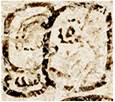



MHD HelmkeEtAl-ARotKV.p52.fig38a HelmkeEtAl-ARotKV.p52.fig38b HelmkeEtAl-ARotKV.p52.fig38c
Komkom Vase C10 Komkom Vase E7 Komkom Vase E12 Komkom Vase M6
<pa:ka>.xi <pa:ka>.xi <pa:ka>.xi <pa:ka>.xi

MHD (mayavase.com)
K3058 O3
<ka:pa>.xi



HelmkeEtAl-ARotKV.p52.fig38d HelmkeEtAl-ARotKV.p52.fig38e HelmkeEtAl-ARotKV.p52.fig38f
NTN Drawing 19 A3-A4a NTN Drawing 48 A1 NTN Drawing 62 B2
pa.ka xi <pa:ka>.xi <pa.ka>:xi
· In one sense a very rare verb, in another sense a well-attested one. Rare in as much as it’s found only on the Komkom Vase, one other vase, and in drawings at NTN; but well-attested in as much as it occurs on five different inscriptions (the three NTN drawings being viewed as three distinct and independent inscriptions), and that it even occurs four times on the Komkom vase.
· The order of the glyphs in K3058 is slightly unusual.
· The meaning is generally given as “to return”:
o EB.p145.pdfp150.#1: pakax- iv. to return [giving as reference NTN Drawing 48 and Drawing 62]. EB.p145.pdfp150.fn205: It is possible that the suffix -ax marks a certain kind of (medio)passives or simply derives an intransitive from a transitive root as CPN Stela J provides spellings with -xa on known verbs as in ma-ka-xa > makax (see mak- tv.), CH’AM/K’AM-xa > ch’amax/k’amax (see ch’am- tv., k’am- tv.), and pu-ku-xa > pukux (see puk- iv.) but also on verbs of which the meaning is still opaque as in sa-ka-xa > sakax (sak- “to whiten?”).
o Lopes-OtTaIoaVitPVM.p4.para4 also gives this meaning, but says that it might be a verb with the more general meaning of “to arrive”.
o AT-YT2021-lecture16.t0:19:03 says that it means “to go somewhere and return” in a single verb. He explains that it’s used for going into town: going there, walking around, and then returning home – pilgrims also do this for places they make a pilgrimage to, as do soldiers in conquering a town, or involved in a military action.